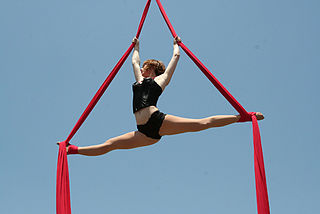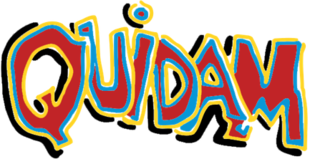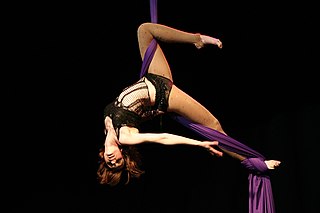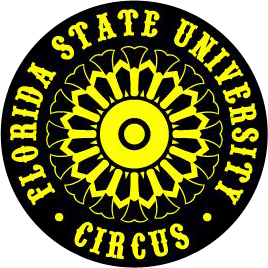
Acrobatics is the performance of human feats of balance, agility, and motor coordination. Acrobatic skills are used in performing arts, sporting events, and martial arts. Extensive use of acrobatic skills are most often performed in acro dance, circus, gymnastics, and freerunning and to a lesser extent in other athletic activities including ballet, slacklining and diving. Although acrobatics is most commonly associated with human body performance, the term is used to describe other types of performance, such as aerobatics.

A trapeze is a short horizontal bar hung by ropes, metal straps, or chains, from a ceiling support. It is an aerial apparatus commonly found in circus performances. Trapeze acts may be static, spinning, swinging or flying, and may be performed solo, double, triple or as a group act.
The Spanish web is an aerial circus skill in which a performer climbs and performs various tricks on an apparatus resembling a vertically hanging rope. It is similar in appearance and performance style to the corde lisse, but with the addition of loops on the rope for hands or feet, permitting one to perform a variety of spinning motions. The name refers to both the apparatus and the performance.

Quidam was the ninth stage show produced by Cirque du Soleil. It premiered in April 1996 and has been watched by millions of spectators around the world. Quidam originated as a big-top show in Montreal and was converted into an arena format beginning with its 2010 tour in North America. It then changed back to the Big Top for a 3-month run in Seoul, South Korea before returning to an arena show for its tour to Oceania. The show performed for the final time in Christchurch, New Zealand on February 26, 2016.

A fly system, or theatrical rigging system, is a system of ropes, pulleys, counterweights and related devices within a theater that enables a stage crew to fly (hoist) quickly, quietly and safely components such as curtains, lights, scenery, stage effects and, sometimes, people. Systems are typically designed to fly components between clear view of the audience and out of view, into the large space, the fly loft, above the stage.

Aerial modern dance is a subgenre of modern dance first recognized in the United States in the 1970s. The choreography incorporates an apparatus that is often attached to the ceiling, allowing performers to explore space in three dimensions. The ability to incorporate vertical, as well as horizontal movement paths, allows for innovations in choreography and movement.

A stagehand is a person who works backstage or behind the scenes in theatres, film, television, or location performance. Their work include setting up the scenery, lights, sound, props, rigging, and special effects for a production.

The flying trapeze is a specific form of the trapeze in which a performer jumps from a platform with the trapeze so that gravity makes the trapeze swing.

Aerial silks is a type of performance in which one or more artists perform aerial acrobatics while hanging from a specialist fabric. The fabric may be hung as two pieces, or a single piece, folded to make a loop, classified as hammock silks. Performers climb the suspended fabric without the use of safety lines and rely only on their training and skill to ensure safety. They use the fabric to wrap, suspend, drop, swing, and spiral their bodies into and out of various positions. The fabric may also be used to fly through the air, striking poses and figures. Some performers use rosin on their hands and feet to increase the friction and grip on the fabric. Aerial silks is a demanding art and requires a high degree of strength, power, flexibility, courage, stamina, and grace to practice.
The National Circus School is a professional circus school located in Montreal, Quebec, Canada. It is for higher education in the art of circus. The NCS also offers academic subjects at the secondary and college levels. It is one of the only circus school in the Americas to offer professional programs in circus arts: Preparatory program, Circus and High School Studies, and Higher Education in Circus arts. It also prepares professional circus arts educators.

Static trapeze, also known as fixed trapeze, is a type of circus art performed on the trapeze. In contrast to the other forms of trapeze, on static trapeze the bars and ropes mainly stay in place.

The aerial hoop is a circular steel apparatus suspended from the ceiling, on which circus artists may perform aerial acrobatics. It can be used static, spinning, or swinging. Tricks that can be performed include the Candlestick, Bird's Nest and Crescent Moon
A theatrical technician, also known as a theatrical tech, theatre technician, or theatre tech is a person who operates technical equipment and systems in the performing arts and entertainment industry. In contrast to performers, this broad category contains all "unseen" theatrical personnel who practice stagecraft and are responsible for the logistic and production-related aspects of a performance including designers, operators, and supervisors.
Bandaloop, formerly Project Bandaloop and stylized as BANDALOOP, is an aerial dance company founded in 1991 by Amelia Rudolph. The company's incorporation of climbing technology allows dancers to execute routines on vertical surfaces and perform in public spaces.
The American Society of Theatre Consultants (ASTC) is a professional organization whose main goal is to apprise owners, contractors and/or architects of the services that a theatre consultant can perform, whether it be for a new or renovated facility.

The Florida State University (FSU) "Flying High" Circus is an extra-curricular activity under FSU's Division of Student Affairs. Located in Tallahassee, Florida, it is one of two such collegiate circuses in the United States, along with Illinois State University's Gamma Phi Circus. All members of the FSU Circus are required to be a degree-seeking student registered at Florida State University and are accepted after an audition.
Rigging in entertainment can be broken down into two main subjects – theatrical rigging and arena-style rigging. All the same skills apply in both genres. The first takes place in a theatre, and typically involves the theatre's permanent fly system. The other in an arena or "exposed structure venue" such as a convention center, ballroom, warehouse etc.
The Philadelphia School of Circus Arts (PSCA) is a contemporary circus school in Philadelphia. It began in June 2008.










